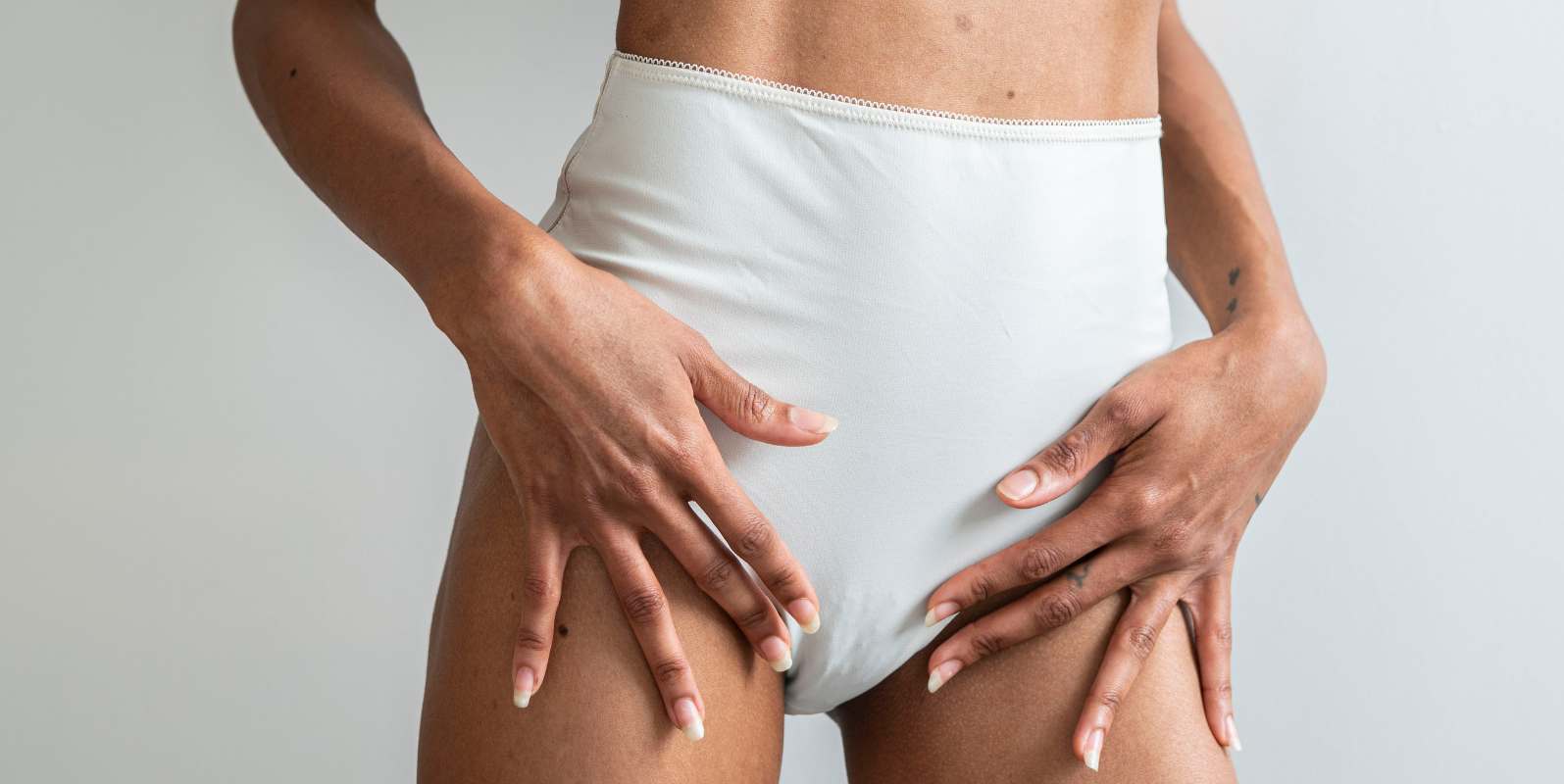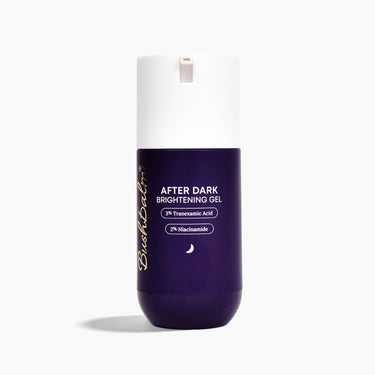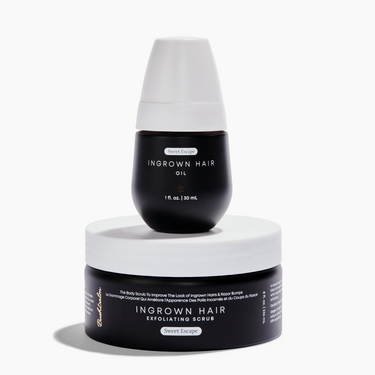The Connection Between Shaving and Dark Spots
Have you ever noticed that a lot of your dark spots appear in areas where you shave? Like the armpits, the legs, the bikini line etc. A possible source of the dark spots and hyperpigmentation is the act of shaving itself. Keep reading to learn about: 1) how shaving can cause dark spots; 2) factors that increase the risk of dark spots when shaving; and 3) how to prevent dark spots.
Click here to find out everything you need to know about dark spots including cause, treatment, and prevention.

How Does Shaving Cause Dark Spots?
Post-inflammatory hyperpigmentation
Post-inflammatory hyperpigmentation is caused by abrasions to the skin's surface such as acne, eczema, ingrown hairs, scrapes or cuts, and the list goes on. Shaving can be quite abrasive on the skin. After all, you are gliding sharp blades up and down your body. As noted by Dr. Ruth Arumala (a board certified gynaecologist):
When one shaves, the hair follicle is irritated and will balloon out to protect the skin. This reaction creates pimple-like bumps which later lead to acne scars, dark spots and discolouration.
The inflammation that results from an injury triggers melanocyte skin cells to the area of injury. The excessive concentration of melanocyte will leave a darker and discoloured patch around the area where the wound once was.

Factors that contribute to post-inflammatory hyperpigmentation after shaving
There are a number of (easily avoidable) factors that contribute to making the interaction between skin and blade more irritating.

Shaving without moisturizing shave cream
When we shave, the first blade of the razor will lift up the hair strand so the next blade can slice it off. Without a moisturizing agent to help lift the hair strand, the razor is forced to tug on the skin. This tugging causes excessive irritation which can lead to razor bumps. In response, melanocytes will rush to the area to protect the skin and leave dark spots behind. Thus, it’s important to use some sort of moisturizing agent when you shave - whether that is conditioner or the shave cream of your choice.
Click here to learn how to shave.
Pseudofolliculitis Barbae (Razor bumps)
Razor bumps are another term for ingrown hairs. Ingrown hairs are strands of hair that grow back into the skin. Ingrown hairs tend to really irritate the skin and in severe cases can become infected. To heal the skin from the wound, the body sends melanin to the area as a protection. Melanin is the brown pigment that creates the appearance of dark spots. Once the ingrown hair finally disappears, it will leave a darkened scar in its place.
Click here to learn more about ingrown hairs, including causes, treatment and prevention techniques.
Dull razor
When your razor is dull, it takes more strokes to remove your unwanted hair. The 3-4 extra strokes irritate the skin substantially by causing micro-abrasions (little wounds) on the surface. These abrasions leave the skin vulnerable to infection, irritation, and razor bumps. As previously mentioned, the body responds to this by sending brown pigmented melanocytes to protect the wounded area.
Click here to learn about razor bumps, including causes and preventive techniques.
How to Prevent Dark Spots Before/After Shaving
Apply a Dark Spot Treatment Oil after shaving
The Bushbalm™ Bermuda Oil is a 100% natural and vegan skincare product that naturally reduces the look of hyperpigmentation and dark spots found anywhere on the body. The Bermuda formula gently breaks down melanin that's built up in the skin and overtime will help you achieve a more even skin tone. The combination of fractionated coconut carrier oil, lemon essential oil, and rare copaiba oil work to even and diffuse the appearance of dark spots and blemishes. Applying this oil after shaving will soothe the skin and prevent the formation of dark spots.
Click here to find out why Bermuda Oil is a fan favourite!

Trim before shaving
Having a trimmer on deck will ensure that the interaction between the razor and skin is as seamless as possible. Trimming before shaving is crucial for 3 reasons: 1) it minimizes tugging; 2) it prevents razor bumps; and 3) it prevents ingrown hairs. By avoiding tugging and razor bumps, the skin will remain wound-free and the risk of post-inflammatory hyperpigmentation will decrease significantly.
Click here to learn about how to use the Francesca Trimmer™.

Minimize tugging
The Francesca trimmer™ will cut the hair down to the optimal length so that your razor does not tug on the skin. When the skin is pulled and tugged too much, the risk of getting nicks and cuts increases. Nics and cuts can be super painful and can get infected.

Prevent razor bumps
Trimming before shaving will prevent razor bumps by minimizing blade clog. If you go straight to work without a trim, you’ll notice your blade clogging more often. When hairs clogs the razor, the blade becomes less sharp. This translates to more strokes needed to sufficiently remove the hair. The extra strokes will irritate the skin and cause micro-abrasions on the surface. Trimming the hair down before shaving will minimize blade clog and in turn prevent razor bumps.

*Note: trim against the direction of grain - this will not irritate the skin because the blade does not touch the surface. What this will do is force all the hair to stand in the same direction. Recap: Shave with the grain - Trim against the grain.
Prevent ingrown hairs
Sometimes the body hair grows in different directions. This poses an issue when it comes time to shave - some hair strands could be cut at a weird angle and fall beneath the skin’s surface. When it is time for the hair to grow, the sharp tip and awkward position of the cut will cause the hair strand to curl back into the skin and remain trapped beneath the skin’s surface. This could lead to angry ingrown hairs and razor bumps - not fun. Ingrown hairs can become infected and seriously irritate the skin. This could lead to scarring and eventually a dark spot as melanin pigments rush to protect the area.
The Francesca Trimmer™ is designed to comb all the hair in the same direction and cut it down to the same size. This will prevent ingrown hairs and razor bumps caused by being shaved at a weird angle.

Cleanse prior to shaving
Throughout the day, dirt and oil will accumulate on the surface of our skin. If you remove hair without properly cleaning the area beforehand, you run the risk of infecting the freshly opened hair follicles. Oils and dirt can seep into your skin causing a red and angry rash to appear in its place. This increases the risk of infection and swelling which could lead to scarring and dark spots.

Never use an old razor blade
Old razors pose two risks for the skin: 1) they are dull; and 2) they contain bacteria. As previously mentioned, dull razors increases the number of micro-abrasions leaving the skin vulnerable to infection. Old blades also carry bacteria. The bacteria on the blade will seep right into the freshly opened hair follicles. This bacteria can lead to infected ingrown hairs.
That is why it is necessary to have a new, clean, and sharp razor on deck. We recommend using a razor 10 times before changing it out.
Shave with the grain
Shaving with the grain (that is, the same direction as hair growth) will minimize the risk of ingrown hairs. When we shave, the first blade of the razor will lift up the hair strand so the next blade can slice it off. If we shave against the grain, the first blade could pick up the hair strand too much. The second blade could then cut the hair below the skin line and give the hair strand a sharp edge. When it is time for the hair to grow, the sharp tip and awkward position of the cut will cause the hair strand to curl back into the skin and remain trapped beneath the skin’s surface. As previously mentioned, ingrown hairs can become infected and later lead to scarring and a hyperpigmentation. Shaving with the grain will minimizes the risk of ingrown hairs and by the same token prevent dark spots.




















